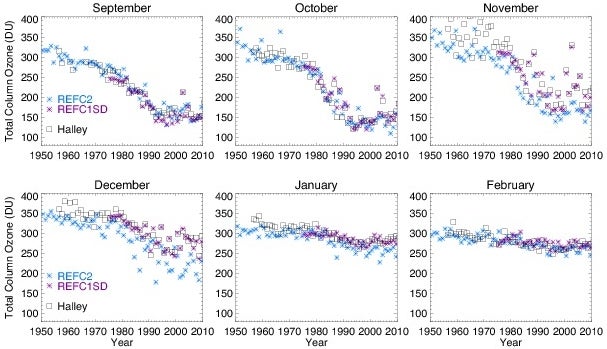WACCM Model Simulates the Antarctic Ozone Hole
The Montreal Protocol on Substances that Deplete the Ozone Layer and its amendments mandate assessments of the status of atmospheric ozone every four years. A key input to these assessment reports is derived from integrations of models that simulate the past, present, and future chemistry of the ozone layer. Integrations using the whole atmosphere option of the CESM are underway for the upcoming 2014 assessment. This model, known as the Whole Atmosphere Community Climate Model (WACCM), simulates interactive chemistry from the Earth’s surface to above 100 km. The figure compares the total ozone observed above the Halley Bay station in Antarctica with that from two WACCM simulations. The simulations labeled REFC1SD use temperature, wind, and other key meteorological fields determined from analyses of observations; the comparison indicated that the model ozone agrees very well with the observed ozone. In the simulations labeled REFC2, the model itself calculates all the meteorological fields. This free-running model is a much more stringent test of model performance because the chemistry is quite sensitive to the atmospheric temperature and the temperature in turn is sensitive to ozone and to various aspects of the model dynamics. The figure indicates that the interactive WACCM integration REFC2 does an excellent job in showing the development of the Antarctic ozone hole over the period 1950-2010. This is a marked improvement over previous versions of the model, which tended to be too cold in Southern Hemisphere spring. Such free-running models are necessary for predictions of the ozone recovery over the coming decades.

Figure 1. WACCM integration REFC2 showing the development of the Antarctic ozone hole over the period 1950-2010.
